Dynamics and Predictions of Urban Expansion in Java, Indonesia: Continuity and Change in Mega-Urbanization
Abstract
1. Introduction
2. Research Location and Methods
2.1. Research Location
2.2. Land Cover Prediction
2.3. Klassen Typology
- (1)
- Quadrant 1 (Q1): The cities/regencies in Quadrant 1 are categorized as “Fast Growing—Urbanized Regions”. The urbanization level of the region is higher than the average urbanization level in Java, and the urban growth rate of the region is also faster than the average urban growth rate in Java. The city/regency in Quadrant 1 can be called a developed/mature region.
- (2)
- Quadrant 2 (Q2): The cities/regencies in Quadrant 2 are categorized as “Fast Growing—Less Urbanized Regions”. The urbanization level of the region is lower than the average urbanization level in Java, but the urban growth rate of the region is faster than the average urban growth rate in Java. The city/regency in Quadrant 2 can be called a potential/developing region.
- (3)
- Quadrant 3 (Q3): The cities/regencies in Quadrant 3 are categorized as “Slow Growing—Less Urbanized Regions”. The urbanization level of the region is lower than the average urbanization level in Java, and the urban growth rate of the region is also slower than the average urban growth rate in Java. The city/regency in Quadrant 3 can be called an undeveloped region.
- (4)
- Quadrant 4 (Q4): The cities/regencies in Quadrant 4 are categorized as “Slow Growing—Urbanized Regions”. The urbanization level of the region is higher than the average urbanization level in Java, but the urban growth rate of the region is slower than the average urban growth rate in Java. The city/regency in Quadrant 4 can be called a saturated region.
3. Results
3.1. Land Cover Change and Its Predictions
3.2. Urban Growth between Metropolitan and Non-Metropolitan Areas
3.3. Klassen Typology of Urbanization Level and Urban Growth
4. Discussion
4.1. New Centralities of Spatial Dynamics?
4.2. Mega-Urbanization beyond Existing Metropolitan Boundaries
5. Conclusions
Author Contributions
Funding
Data Availability Statement
Conflicts of Interest
References
- McGee, T.; Greenberg, C. The emergence of extended metropolitan regions in ASEAN: Towards the Year. Asean Econ. Bull. 1992, 9, 22–44. [Google Scholar] [CrossRef]
- Jones, G.W. Southeast Asian urbanization and the growth of mega-urban regions. J. Popul. Res. 2002, 19, 119–136. [Google Scholar] [CrossRef]
- Jones, G.W.; Douglass, M. (Eds.) Mega-Urban Regions in Pacific Asia: Urban Dynamics in a Global Era; Nus Press: Singapore, 2008. [Google Scholar]
- McGee, T.G.; Robinson, I.M. (Eds.) The Mega-Urban Regions of Southeast Asia; UBC Press: Toronto, ON, Canada, 1995. [Google Scholar]
- McGee, T. Deconstructing the mega-city: A case study of the Jakarta mega-urban region(Jabodetabek) in the first decade of the 21st Century; Preliminary Draft; Kyoto University: Kyoto, Japan, 2012. [Google Scholar]
- Champion, T.; Hugo, G. Introduction: Moving beyond the urban-rural dichotomy. In New Form of Urbanisation; Champion, T., Hugo, G., Eds.; Ashgate Publishing Company: Hants, UK, 2004; pp. 3–24. [Google Scholar]
- Harrison, J.; Hoyler, M. (Eds.) Megaregions: Globalization s New Urban Form? Edward Elgar Publishing: Cheltenham, UK, 2015. [Google Scholar]
- Yeh, A.G.-O.; Chen, Z. From cities to super mega city regions in China in a new wave of urbanisation and economic transition: Issues and challenges. Urban Stud. 2019, 57, 636–654. [Google Scholar] [CrossRef]
- Lu, H.; de Jong, M.; Song, Y.; Zhao, M. The multi-level governance of formulating regional brand identities: Evidence from three Mega City Regions in China. Cities 2020, 100, 102668. [Google Scholar] [CrossRef]
- Priemus, H.; Hall, P. Multifunctional urban planning of mega-city-regions. Built Environ. 2004, 30, 338–349. [Google Scholar] [CrossRef]
- Xu, J.; Yeh, A. Governance and Planning of Mega-City Regions. In An International Comparative Perspective; Routledge Studies in Human Geography: Devon, UK, 2011. [Google Scholar]
- Lang, R.; Knox, P.K. The new metropolis: Rethinking megalopolis. Reg. Stud. 2009, 43, 789–802. [Google Scholar] [CrossRef]
- Mori, T. A Modeling of megalopolis formation: The maturing of city systems. J. Urban Econ. 1997, 42, 133–157. [Google Scholar] [CrossRef]
- Vicino, T.J.; Hanlon, B.; Short, J.R. Megalopolis 50 years on: The Transformation of a city region. Int. J. Urban Reg. Res. 2007, 31, 344–367. [Google Scholar] [CrossRef]
- McGrath, B.; Shane, D.G. Metropolis, megalopolis and metacity. In The Sage Handbook of Architectural Theory; Sage: London, UK, 2012; pp. 641–657. [Google Scholar]
- Hall, P.G.; Pain, K. (Eds.) The Polycentric Metropolis: Learning from Mega-City Regions in Europe; Routledge: London, UK, 2006. [Google Scholar]
- Halbert, L.; Convery, F.J.; Thierstein, A. Reflections on the polycentric metropolis. Built Environ. 2006, 32, 110–113. [Google Scholar] [CrossRef]
- Hall, P. The polycentric metropolis: A western European perspective on mega-city regions. In Governance and Planning of Mega-City Regions; Routledge: London, UK, 2010; pp. 45–66. [Google Scholar]
- Liu, Z.; Liu, S. Polycentric Development and the role of urban polycentric planning in China’s mega cities: An examination of Beijing’s metropolitan area. Sustainability 2018, 10, 1588. [Google Scholar] [CrossRef]
- Zhao, M.; Derudder, B.; Huang, J. Polycentric development in China’s mega-city regions, 2001–2008: A comparison of the Yangtze and Pearl River Deltas. J. Geogr. Soc. Berl. 2017, 148, 1–13. [Google Scholar]
- Friedmann, J.; Sorensen, A. City unbound: Emerging mega-conurbations in Asia. Int. Plan. Stud. 2019, 24, 1–12. [Google Scholar] [CrossRef]
- Friedmann, J. Thinking about mega-conurbations and planning1. In Handbook of Megacities and Megacity-Regions; Edward Elgar Publishing: Cheltenham, UK, 2020; pp. 21–32. [Google Scholar]
- Shatkin, G. The planning of Asia’s mega-conurbations: Contradiction and contestation in extended urbanization. Int. Plan. Stud. 2019, 24, 68–80. [Google Scholar] [CrossRef]
- Friedmann, J. Thinking about complexity and planning. Int. Plan. Stud. 2019, 24, 13–22. [Google Scholar] [CrossRef]
- Octifanny, Y.; Hudalah, D. Urban Agglomeration and extension in northern coast of west java: A transformation into mega region. IOP Conf. Ser. Earth Environ. Sci. 2017, 79, 012011. [Google Scholar] [CrossRef]
- Harrison, J.; Gu, H. Planning megaregional futures: Spatial imaginaries and megaregion formation in China. Reg. Stud. 2019, 55, 77–89. [Google Scholar] [CrossRef]
- Firman, T.; Fahmi, F.Z. The Privatization of Metropolitan Jakarta’s (Jabodetabek) urban fringes: The early stages of “post-suburbanization” in Indonesia. J. Am. Plan. Assoc. 2017, 83, 68–79. [Google Scholar] [CrossRef]
- Rustiadi, E.; Pravitasari, A.E.; Setiawan, Y.; Mulya, S.P.; Pribadi, D.O.; Tsutsumida, N. Impact of continuous Jakarta megacity urban expansion on the formation of the Jakarta-Bandung conurbation over the rice farm regions. Cities 2020, 111, 103000. [Google Scholar] [CrossRef]
- Pravitasari, A.E.; Rustiadi, E.; Mulya, S.P.; Widodo, C.E.; Indraprahasta, G.S.; Fuadina, L.N.; Karyati, N.E.; Murtadho, A. Measuring urban and regional sustainability performance in Java: A comparison study between 6 metropolitan areas. IOP Conf. Ser. Earth Environ. Sci. 2020, 556, 012004. [Google Scholar] [CrossRef]
- Badan Pusat Statistik. Indeks Pembangunan Manusia Jakarta (ID). Available online: https://www.bps.go.id/publication/2020/08/28/a180fbf968ecf6fc9fde1d2a/indeks-pembangunan-manusia-2019.html (accessed on 15 November 2023).
- Pravitasari, A.E.; Rustiadi, E.; Priatama, R.A.; Murtadho, A.; Kurnia, A.A.; Mulya, S.P.; Saizen, I.; Widodo, C.E.; Wulandari, S. Spatiotemporal distribution patterns and local driving factors of regional development in Java. ISPRS Int. J. Geo-Inf. 2021, 10, 812. [Google Scholar] [CrossRef]
- Gong, J.; Hu, Z.; Chen, W.; Liu, Y.; Wang, J. Urban Expansion Dynamics and Modes in Metropolitan Guangzhou, China. Land Use Policy 2018, 72, 100–109. [Google Scholar] [CrossRef]
- Shofy, Y.F.; Wibowo, A. The Impact of the Trans-Java Toll Road Development on Spatial Planning in the Northern Region of Java Island: A Study Utilizing NDBI and Google Earth Images. Indones. J. Earth Sci. 2023, 3, A611. [Google Scholar] [CrossRef]
- Hill, H. Globalization, inequality, and local-level dynamics: Indonesia and the Philippines. Asian Econ. Policy Rev. 2008, 3, 42–61. [Google Scholar] [CrossRef]
- Indraprahasta, G.S.; Derudder, B. World City-ness in a historical perspective: Probing the long-term evolution of the Jakarta metropolitan area. Habitat Int. 2019, 89, 102000. [Google Scholar] [CrossRef]
- Nas, P.J. Pratiwo Java and de groote postweg, la grande route, the great mail road, Jalan Raya Pos. Bijdr. Tot De Taal-Land-En Volkenkd. 2002, 158, 707–725. [Google Scholar] [CrossRef]
- Octifanny, Y. The history of urbanization in Java Island: Path to contemporary urbanization. TATA LOKA 2020, 22, 474–485. [Google Scholar] [CrossRef]
- Firman, T. The continuity and change in mega-urbanization in Indonesia: A survey of Jakarta–Bandung Region (JBR) development. Habitat Int. 2009, 33, 327–339. [Google Scholar] [CrossRef]
- Firman, T.; Dharmapatni, I.A.I. The emergence of extended metropolitan regions in Indonesia: Jabotabek and Bandung Metropolitan Area. Rev. Urban Reg. Dev. Stud. 1995, 7, 167–188. [Google Scholar] [CrossRef]
- Fuadina, L.N.; Rustiadi, E.; Pravitasari, A.E. The Dynamic of Land Use Changes and Regional Development in Bandung Metropolitan Area. IOP Conf. Ser. Earth Environ. Sci. 2020, 556, 012002. [Google Scholar] [CrossRef]
- Pravitasari, A.E.; Rustiadi, E.; Mulya, S.P.; Setiawan, Y.; Fuadina, L.N.; Murtadho, A. Identifying the driving forces of urban expansion and its environmental impact in Jakarta-Bandung mega urban region. IOP Conf. Ser. Earth Environ. Sci. 2018, 149, 012044. [Google Scholar] [CrossRef]
- Hudalah, D.; Octifanny, Y.; Talitha, T.; Firman, T.; Phelps, N.A. From metropolitanization to megaregionalization: Intentionality in the urban restructuring of Java’s North Coast, Indonesia. J. Plan. Educ. Res. 2020, 44, 292–306. [Google Scholar] [CrossRef]
- Hudalah, D.; Talitha, T.; Lestari, S.F. Pragmatic state rescaling: The dynamics and diversity of state space in Indonesian megaproject planning and governance. Environ. Plan. C Politi-Space 2021, 40, 481–501. [Google Scholar] [CrossRef]
- Nadoushan, M.A.; Soffianian, A.; Alebrahim, A. Modelling land use/cover changes by the combination of markov chain and cellular automata markov (CA-Markov) models. J. Earth Environ. Health Sci. 2015, 1, 16. [Google Scholar] [CrossRef]
- Siddiqui, A.; Siddiqui, A.; Maithani, S.; Jha, A.K.; Kumar, P.; Srivastav, S. Urban growth dynamics of an Indian metropolitan using CA Markov and Logistic Regression. Egypt. J. Remote Sens. Space Sci. 2018, 21, 229–236. [Google Scholar] [CrossRef]
- Parsa, V.A.; Yavari, A.; Nejadi, A. Spatio-Temporal Analysis of Land Use/Land Cover Pattern Changes in Arasbaran Biosphere Reserve: Iran. Model. Earth Syst. Environ. 2016, 2, 1–13. [Google Scholar] [CrossRef]
- Hamad, R.; Balzter, H.; Kolo, K. Predicting land use/land cover changes using a CA-Markov model under two different scenarios. Sustainability 2018, 10, 3421. [Google Scholar] [CrossRef]
- Singh, S.K.; Mustak, S.; Srivastava, P.K.; Szabó, S.; Islam, T. Predicting spatial and decadal LULC changes through cellular automata Markov chain models using earth observation datasets and geo-information. Environ. Process. 2015, 2, 61–78. [Google Scholar] [CrossRef]
- Yudarwati, R.; Sitorus, S.R.; Munibah, K. Arahan pengendalian perubahan penggunaan lahan menggunakan Markov –Cellular automata di Kabupaten Cianjur. Tataloka 2017, 18, 211. [Google Scholar] [CrossRef][Green Version]
- Fitriyanto, B.R.; Helmi, M.; Hadiyanto. Model prediksi perubahan penggunaan lahan dengan pendekatan sistem informasi geografis dan Cellular Automata Markov Chain: Studi kasus Kabupaten Rokan Hulu, Provinsi Riau. J. Teknol. Technoscientia 2019, 11, 137–147. [Google Scholar]
- Jaya, B.; Rustiadi, E.; Fauzi, A.; Pravitasari, A.E. Land conversion and availability of agricultural land in 2035 in Puncak Area Bogor Regency. IOP Conf. Ser. Earth Environ. Sci. 2021, 694, 012052. [Google Scholar] [CrossRef]
- Murtadho, A.; Wulandari, S.; Wahid, M.; Rustiadi, E. Perkembangan Wilayah dan Perubahan Tutupan Lahan di Kabupaten Purwakarta sebagai Dampak dari Proses Konurbasi Jakarta-Bandung. J. Reg. Rural. Dev. Plan. 2018, 2, 195–208. [Google Scholar] [CrossRef][Green Version]
- Ghosh, P.; Mukhopadhyay, A.; Chanda, A.; Mondal, P.; Akhand, A.; Mukherjee, S.; Nayak, S.; Ghosh, S.; Mitra, D.; Ghosh, T.; et al. Application of Cellular Automata and Markov-Chain Model in Geospatial Environmental Modeling—A Review. Remote Sens. Appl. Soc. Environ. 2017, 5, 64–77. [Google Scholar] [CrossRef]
- Landis, J.R.; Koch, G.G. The Measurement of Observer Agreement for Categorical Data. Biometrics 1977, 33, 159–174. [Google Scholar] [CrossRef]
- Wilonoyudho, S. Urbanization and Regional Imbalances in Indonesia. Indones. J. Geogr. 2017, 49, 125–132. [Google Scholar] [CrossRef]
- Dewi, R.S.; Handayani, W.; Rudiarto, I. Artiningsih Understanding the Connection between Urbanization and Hydrometeorological Disasters: An Experience from Central Java Province, Indonesia. IOP Conf. Ser. Earth Environ. Sci. 2022, 1039, 012015. [Google Scholar] [CrossRef]
- Mardiansjah, F.H.; Sugiri, A.; Ma’rif, S. Peri-urbanization of small cities in Java and its impacts on paddy fields: The case of Tegal Urban Region, Indonesia. IOP Conf. Ser. Earth Environ. Sci. 2021, 724, 012023. [Google Scholar] [CrossRef]
- Pravitasari, A.E.; Suhada, A.; Mulya, S.P.; Rustiadi, E.; Murtadho, A.; Wulandari, S.; Widodo, C.E. Land use/cover changes and spatial distribution pattern of rice field decreasing trend in Serang Regency, Banten Province. IOP Conf. Ser. Earth Environ. Sci. 2019, 399, 012033. [Google Scholar] [CrossRef]
- Daris, E.; Aminudin, I.; Feriansyah, A. Determinants of Paddy Fields Conversion in Java Island, Indonesia. In Proceedings of the International Conference on Science and Technology (ICOSAT 2017)-Promoting Sustainable Agriculture, Food Security, Energy, and Environment Through Science and Technology for Development, Ancol, Indonesia, 10 August 2017; Atlantis Press: Amsterdam, The Netherlands, 2017; pp. 95–98. [Google Scholar]
- Pravitasari, A.E.; Yudja, F.P.; Mulya, S.P.; Stanny, Y.A. Land cover changes and spatial planning alignment in Ciamis Regency and its proliferated regions. IOP Conf. Ser. Earth Environ. Sci. 2021, 694, 012065. [Google Scholar] [CrossRef]
- Harjanti, L.T.; Hara, Y. The Determinants of Paddy Fields Conversion in Java and Sumatra [Faktor-Faktor Penentu Konversi Luas Lahan Sawah di Jawa dan Sumatera]. J. Èkon. Dan Kebijak. Publik 2020, 11, 39–52. [Google Scholar] [CrossRef]
- Fitri, T.Y.; Adiwibowo, S.; Pravitasari, A.E. The impact of land-use changes and economic losses of paddy field conversion: A case study of Ciampea Sub-district, Bogor Regency, West Java Province. IOP Conf. Ser. Earth Environ. Sci. 2022, 950, 012104. [Google Scholar] [CrossRef]
- Gandharum, L.; Hartono, D.M.; Karsidi, A.; Ahmad, M. Monitoring urban expansion and loss of agriculture on the north coast of west java province, Indonesia, using Google Earth engine and intensity analysis. Sci. World J. 2022, 1–16. [Google Scholar] [CrossRef]
- Shrestha, R.P. Partoyo Monitoring farmland loss and projecting the future land use of an urbanized watershed in Yogyakarta, Indonesia. J. Land Use Sci. 2013, 8, 59–84. [Google Scholar] [CrossRef]
- Maryati, S.; Humaira, A.N.S.; Pratiwi, F. Spatial pattern of agricultural land conversion in West Java Province. IOP Conf. Ser. Earth Environ. Sci. 2018, 131, 012034. [Google Scholar] [CrossRef]
- Saputro, B.; Priatna, D.; Rosadi, R.; Miyazawa, N. Spatial analysis of paddy field conversion in Purwakarta Regency, West Java, Indonesia. Appl. Environ. Stud. 2023, 4, 22–29. [Google Scholar]
- Damayanti, A.; Setiadi, A.; Febrianti, A.; Setyawan, B.A.; Angelika, P.; Setiadi, R.P. Spatial and Temporal Patterns of the Decreasing Rice Field in Sidorejo Sub-district, Salatiga City, Central Java Province, Indonesia. IOP Conf. Ser. Earth Environ. Sci. 2019, 328, 012057. [Google Scholar] [CrossRef]
- Rahayu, P.; Werdiningtyas, R.; Suminar, L. The Challenge of Rice Farming in Urbanized Region: The case of Sragen District, Central Java. IOP Conf. Ser. Earth Environ. Sci. 2023, 1186, 012013. [Google Scholar] [CrossRef]
- Fiqriyati, A.R.; Panuju, D.R.; Mulya, S.P. The dynamics of rice-field conversion in the surroundings Cipali toll-roads of Subang Regency. IOP Conf. Ser. Earth Environ. Sci. 2022, 950, 012094. [Google Scholar] [CrossRef]
- Novira, N.; Dalimunthe, S.A.; Pinem, M.; Elfayetti; Pinem, K. Rice field conversion and urban agglomeration in Indonesia: Between power and options. J. Phys. Conf. Ser. 2019, 1175, 012184. [Google Scholar] [CrossRef]
- Firmansyah, I.; Yusuf, D.N.; Arumasmawati, A.B. Spatial dynamics of agricultural lands in regions with high pressure land use change (Case study of Purwakarta Regency). IOP Conf. Ser. Earth Environ. Sci. 2019, 363, 012010. [Google Scholar] [CrossRef]
- Mardiansjah, F.H.; Sugiri, A.; Sari, G.P. Urban population growth and their implication to agricultural land in the process of metropolitanization: The case of kabupaten sukoharjo, in metropolitan surakarta. IOP Conf. Ser. Earth Environ. Sci. 2019, 328, 012064. [Google Scholar] [CrossRef]
- Rondhi, M.; Pratiwi, P.A.; Handini, V.T.; Sunartomo, A.F.; Budiman, S.A. Agricultural land conversion, land economic value, and sustainable agriculture: A case study in East Java, Indonesia. Land 2018, 7, 148. [Google Scholar] [CrossRef]
- Pribadi, D.O.; Pauleit, S. The dynamics of peri-urban agriculture during rapid urbanization of Jabodetabek Metropolitan Area. Land Use Policy 2015, 48, 13–24. [Google Scholar] [CrossRef]
- Buchori, I.; Sugiri, A.; Maryono, M.; Pramitasari, A.; Pamungkas, I.T. Theorizing spatial dynamics of metropolitan regions: A preliminary study in Java and Madura Islands, Indonesia. Sustain. Cities Soc. 2017, 35, 468–482. [Google Scholar] [CrossRef]
- Fahmi, F.Z.; Hudalah, D.; Rahayu, P.; Woltjer, J. Extended urbanization in small and medium-sized cities: The case of Cirebon, Indonesia. Habitat Int. 2014, 42, 1–10. [Google Scholar] [CrossRef]
- Mardiansjah, F.H.; Sugiri, A.; Ma’Rif, S. Examining small-town growth and expansion in peri-urban areas of small cities: Evidence from peripheries of three small cities in central java. J. Reg. City Plan. 2021, 32, 216–232. [Google Scholar] [CrossRef]
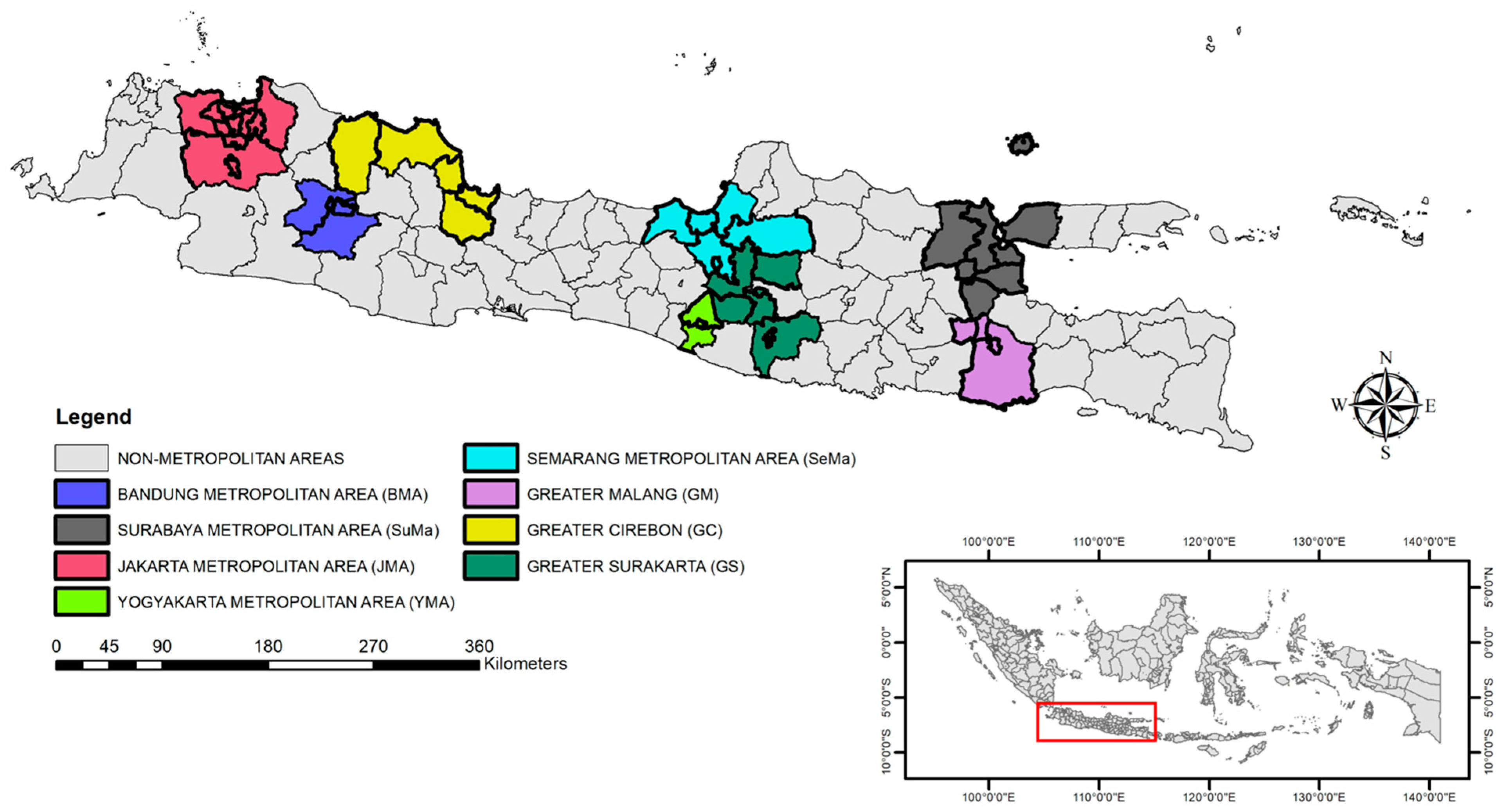
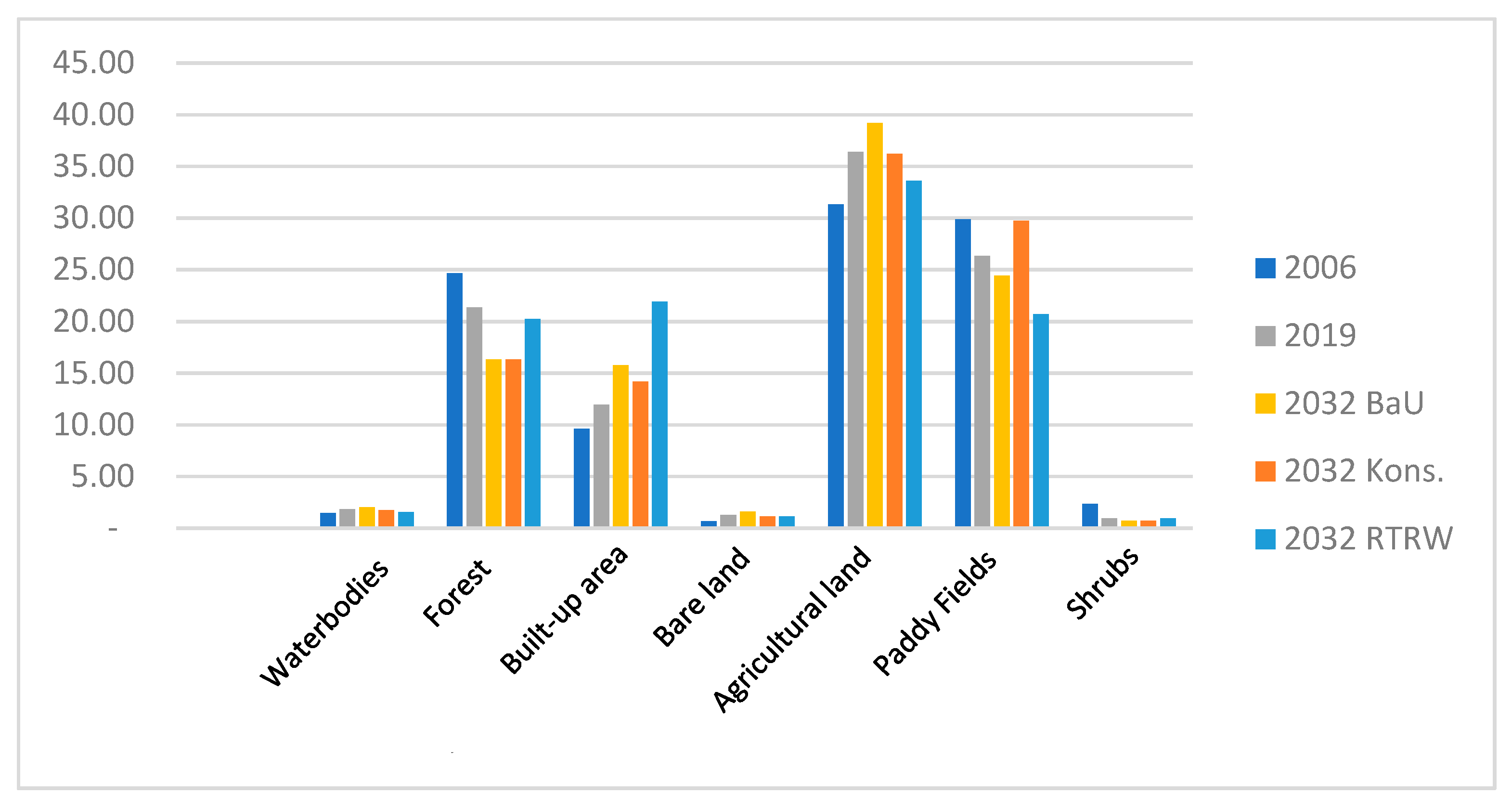
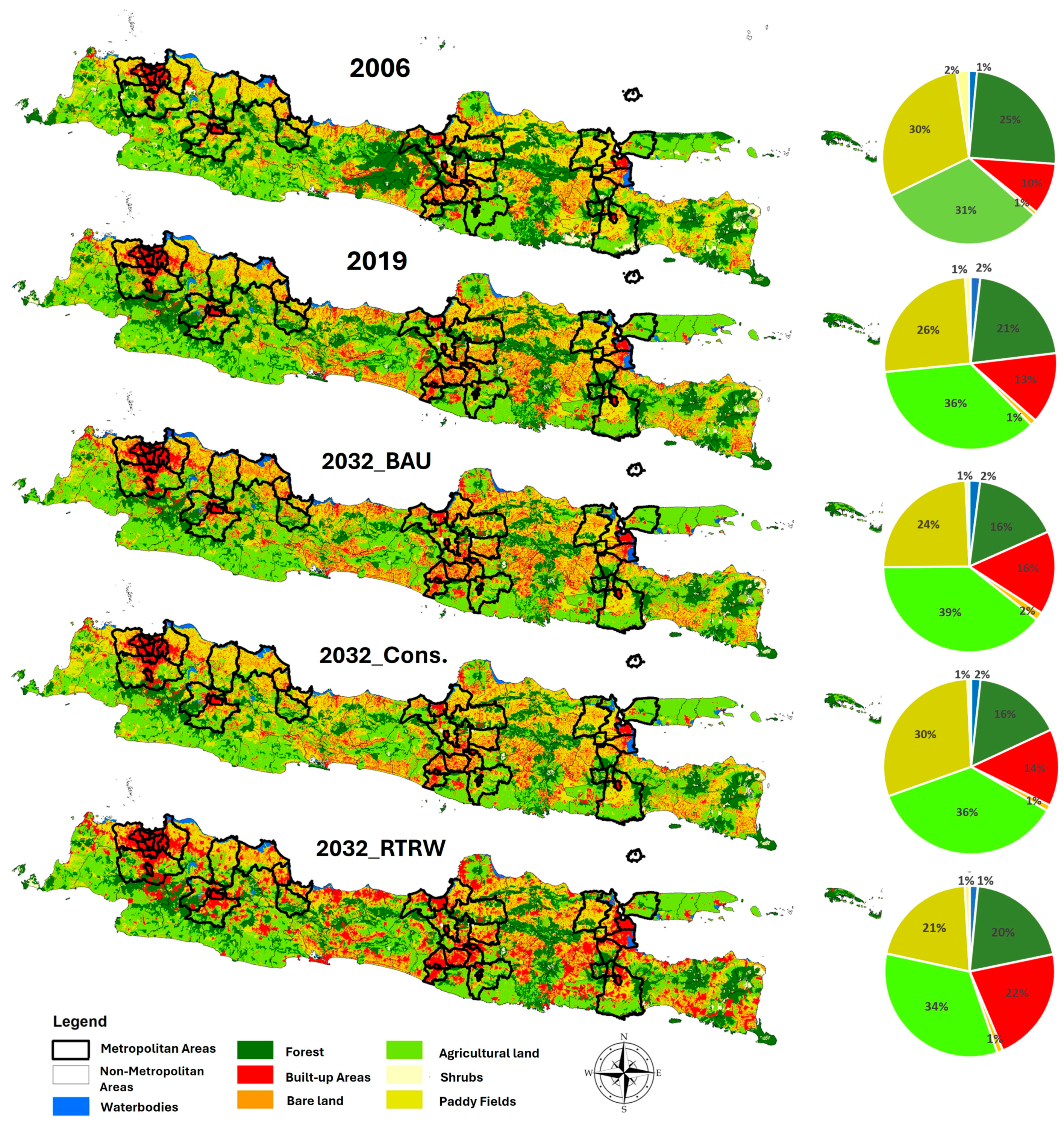
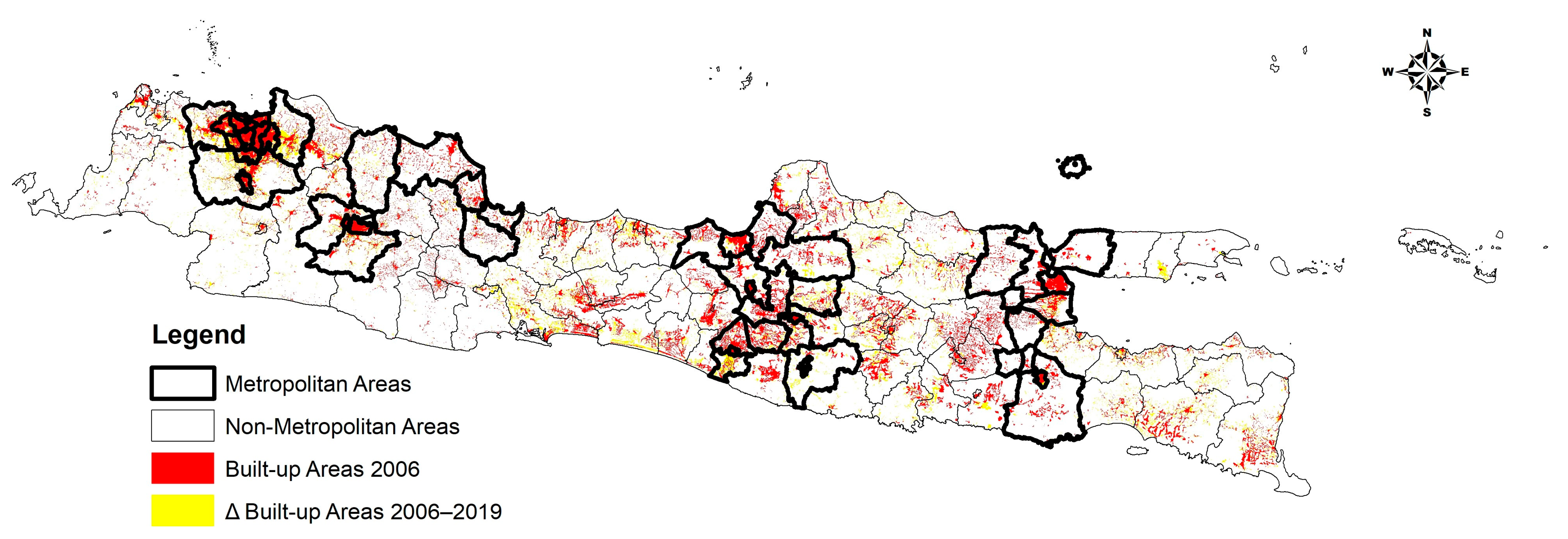
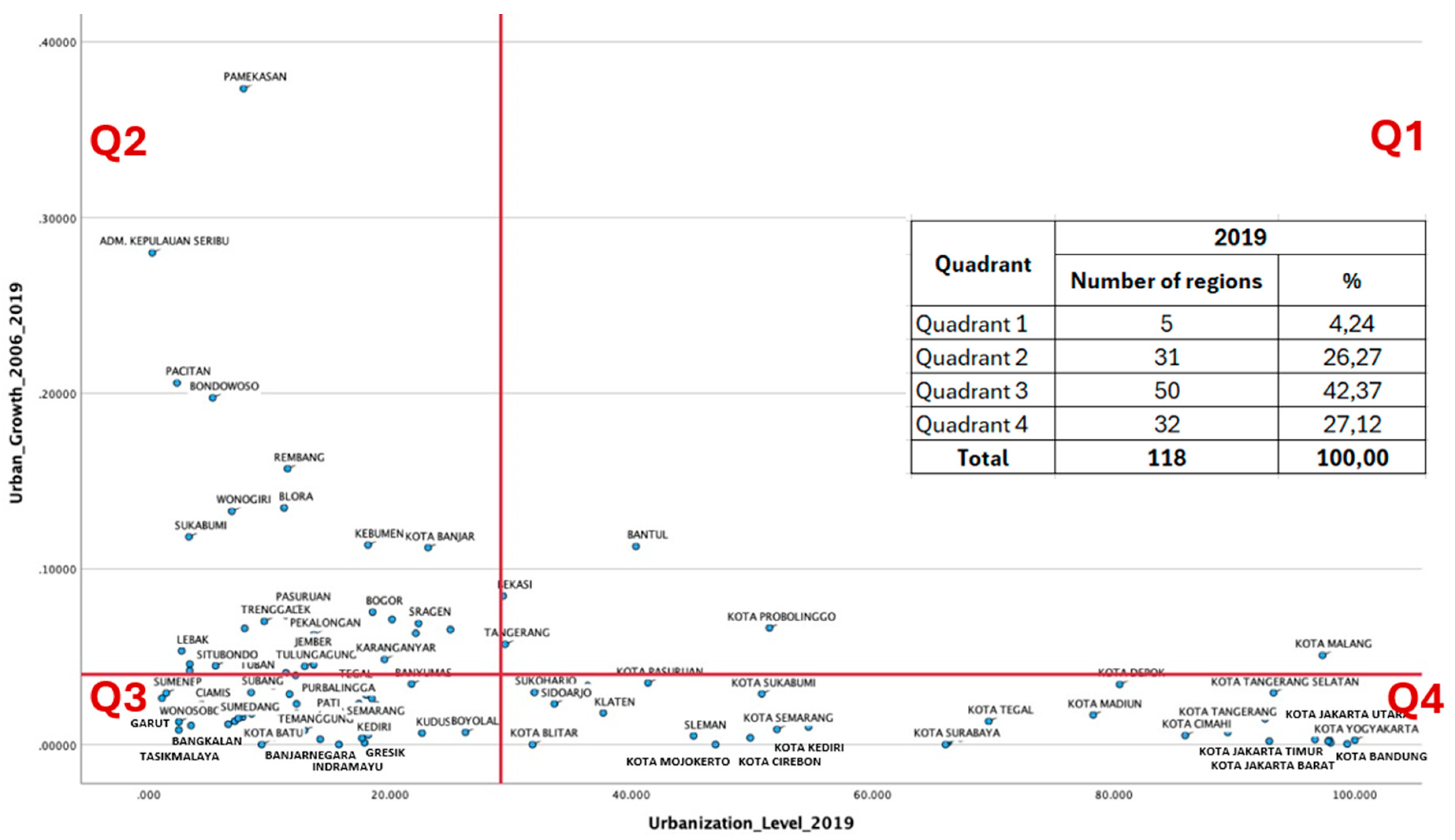
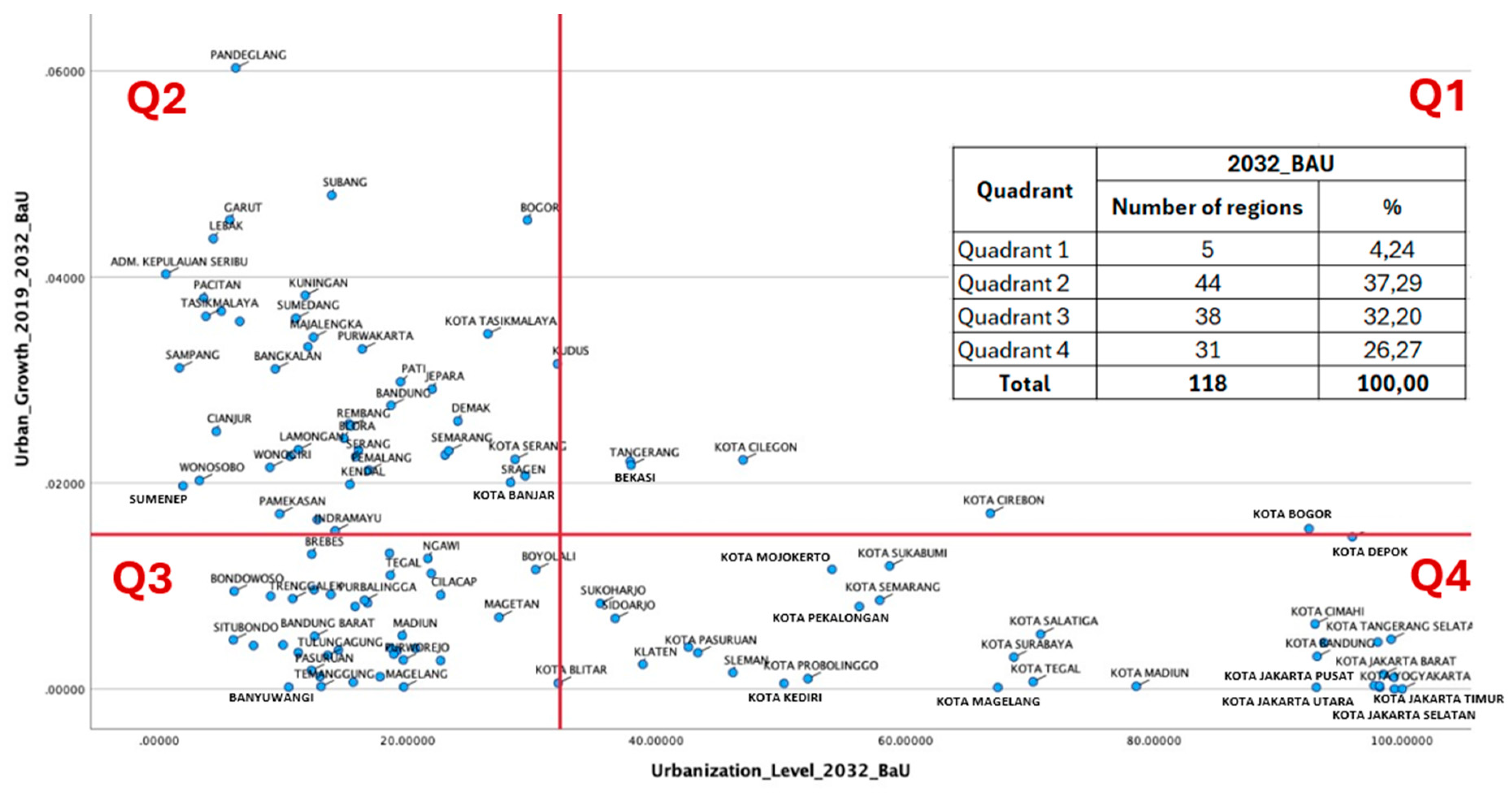
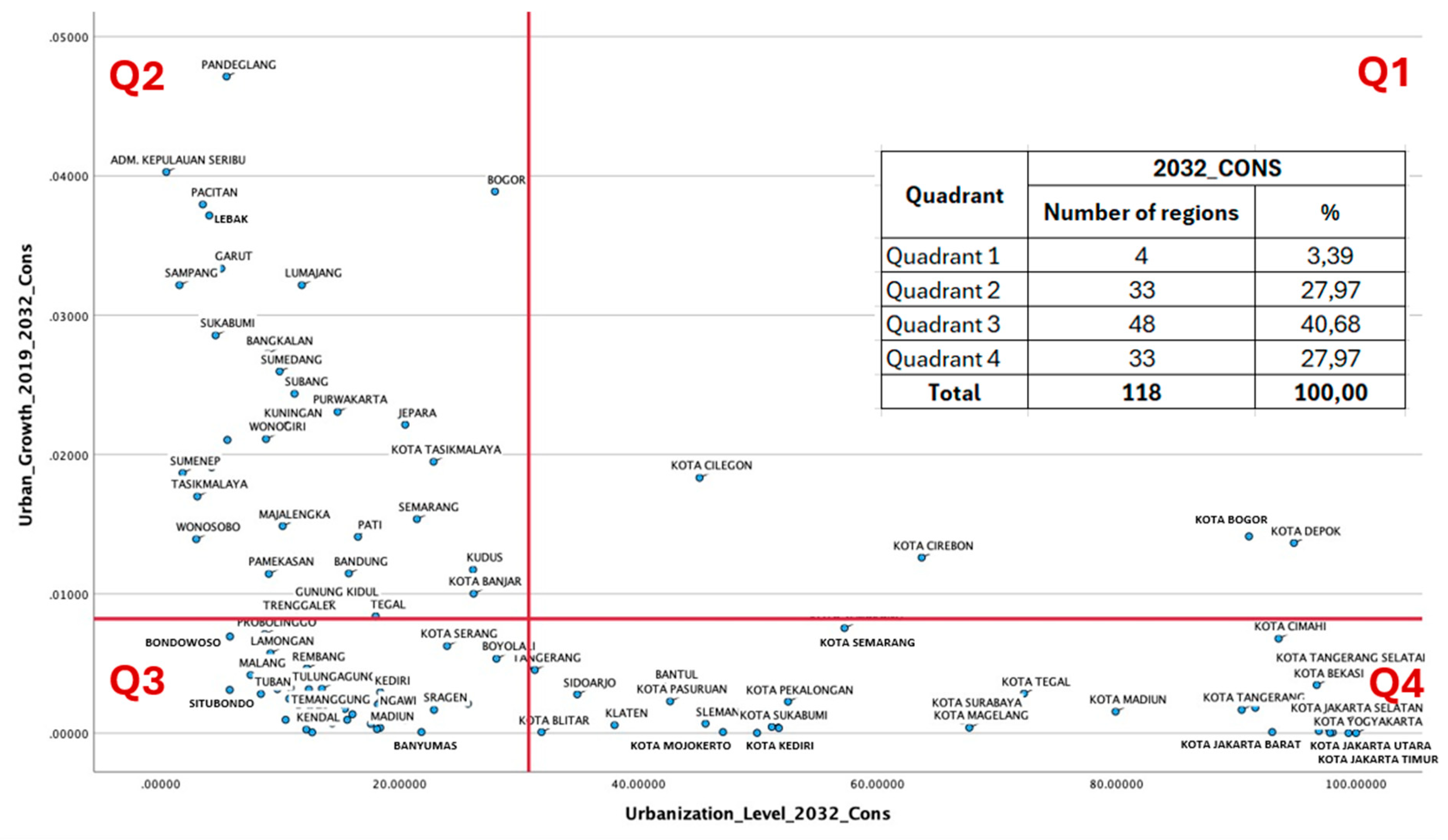
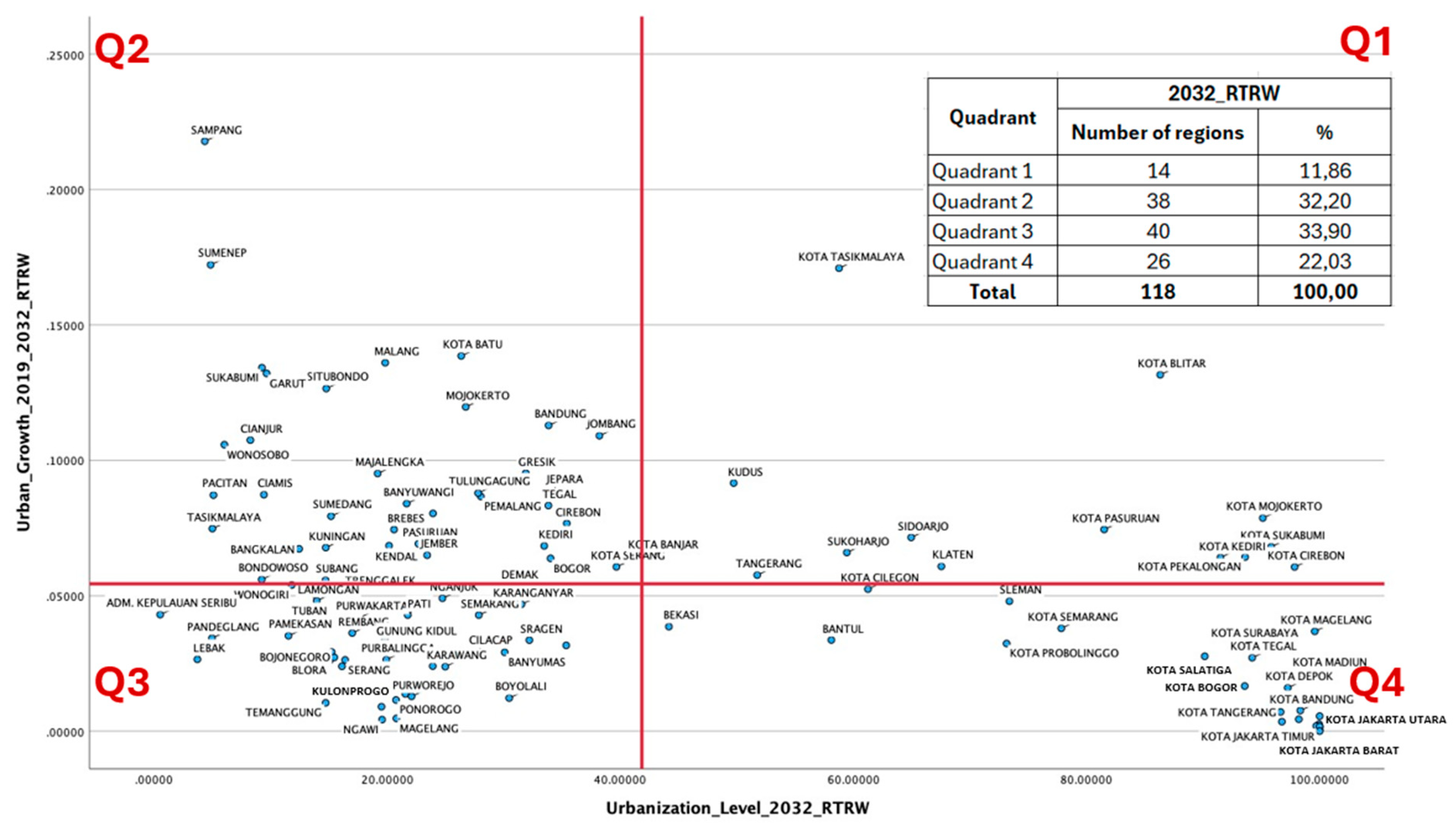
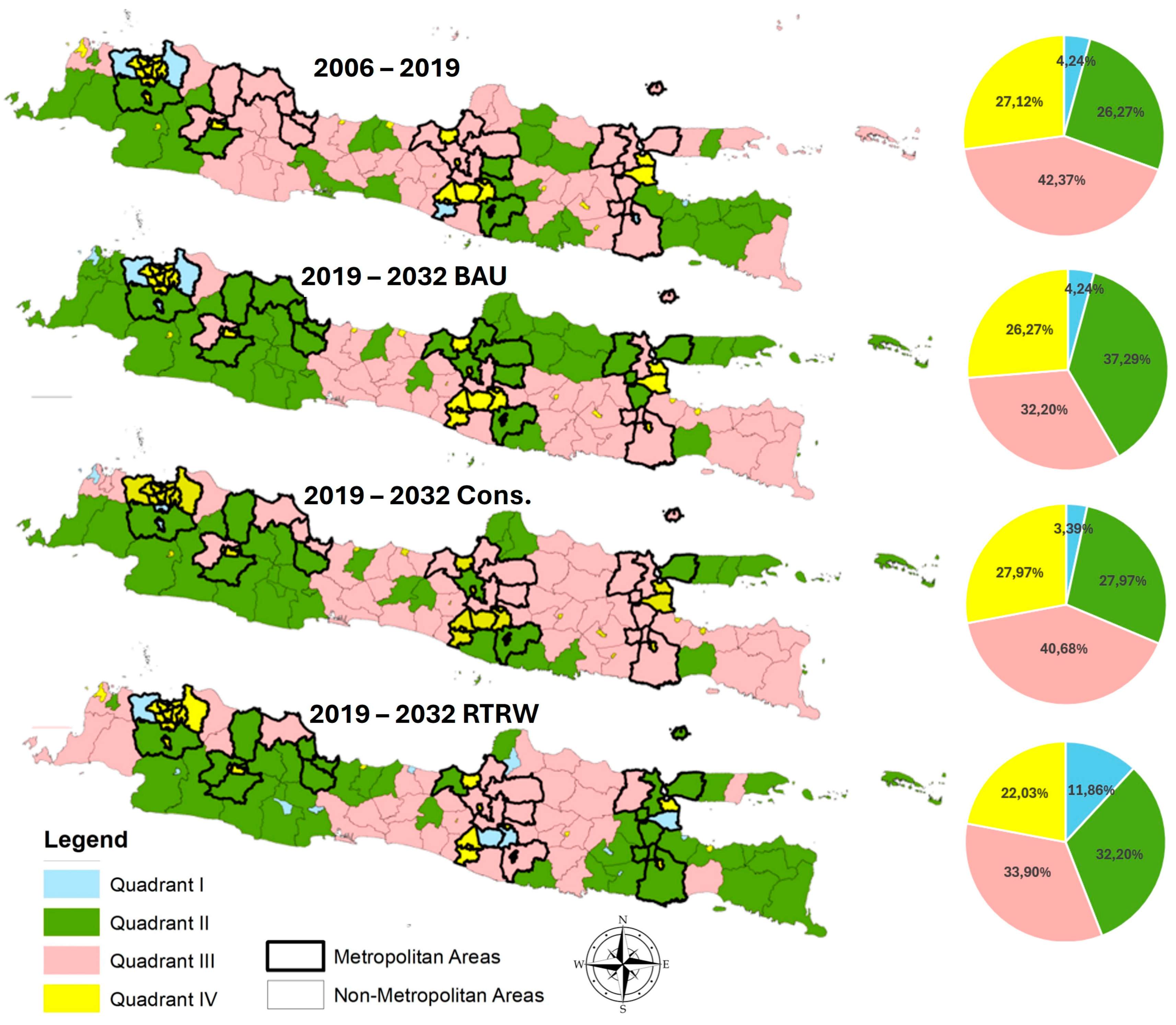
| Concept | Definition | Source |
|---|---|---|
| Megaregion | Megaregions refer to large, interconnected networks of metropolitan areas or cities that are economically and socially integrated. They often transcend traditional political boundaries and encompass multiple urban centers, as well as their surrounding suburban and rural areas. Megaregions are characterized by a high population density, significant economic activity, and shared infrastructure and resources. | [7] |
| Mega-City Region | Mega-city regions are urban agglomerations characterized by extremely high population densities and intense economic activity. These regions typically consist of one or more large metropolitan areas, along with their surrounding suburbs and satellite cities. Mega-city regions are often centers of commerce, industry, and culture, and they exert a significant influence on regional and global affairs. | [8,9,10,11] |
| Megalopolis | A megalopolis is a vast urban region characterized by the continuous expansion and merging of multiple metropolitan areas or cities into a single, densely populated and interconnected urban sprawl. Megalopolises often form along transportation corridors or in areas of high economic activity, and they may encompass several states or even entire countries. | [12,13,14,15] |
| Polycentric Metropolis | A polycentric metropolis is a metropolitan area characterized by the presence of multiple centers of economic activity and urban development, rather than a single dominant city center. In a polycentric metropolis, several smaller cities or urban nodes function as hubs for commerce, industry, and culture, and they are interconnected by transportation networks and shared infrastructure. Polycentric metropolises are often more resilient and sustainable than monocentric cities, as they distribute economic activity and populations across multiple locations. | [16,17,18,19,20] |
| Mega- conurbation | Mega-conurbations are vast urban regions characterized by the continuous expansion and merging of multiple metropolitan areas or urban agglo- merations into a single, highly interconnected, and densely populated urban complex. Mega-conurbations typically encompass large areas of land and are home to millions of people. They may exhibit features of both megalopolises and megaregions, with intense economic activity, significant infrastructure development, and complex social dynamics. | [21,22,23,24] |
| No. | Metropolitan Area | Official Acronym | Localities | Province |
|---|---|---|---|---|
| 1 | Jakarta Metropolitan Area (JMA) | Jabodetabek | North Jakarta City, West Jakarta City, East Jakarta City, South Jakarta City, and Central Jakarta City. Bogor Regency, Bogor City, Depok City, Bekasi Regency, and Bekasi City. Tangerang Regency, Tangerang City, and South Tangerang City. | Jakarta, West Java, Banten |
| 2 | Bandung Metropolitan Area (BMA) | Cekungan Bandung | Bandung City, Bandung Regency, Cimahi City, and West Bandung Regency. | West Java |
| 3 | Semarang Metropolitan Area (SeMA) | Kedungsepur | Semarang City, Semarang Regency, Salatiga City, Kendal Regency, Grobogan Regency, and Demak Regency. | Central Java |
| 4 | Yogyakarta Metropolitan Area (YMA) | Kartamantul | Yogyakarta City, Sleman Regency, and Bantul Regency. | Yogyakarta |
| 5 | Surabaya Metropolitan Area (SuMA) | Gerbangkertosusila | Surabaya City, Gresik Regency, Bangkalan Regency, Mojokerto City, Mojokerto Regency, Sidoarjo Regency, and Lamongan Regency. | East Java |
| 6 | Greater Malang (GM) | Malang Raya | Malang City, Malang Regency, and Batu City. | East Java |
| 7 | Greater Surakarta (GS) | Subosuko- wonosraten | Surakarta City, Boyolali Regency, Sukoharjo Regency, Wonogiri Regency, Sragen Regency, and Klaten Regency. | Central Java |
| 8 | Greater Cirebon (GC) | Rebana | Cirebon City, Cirebon Regency, Subang Regency, Indramayu Regency, and Kuningan Regency. | West Java |
| Urbanization Level (UL) * | |||
|---|---|---|---|
| UL region is lower than average UL in Java (ULi < UL) | UL region is higher than average UL in Java (ULi > UL) | ||
| Urban Growth (UG) ** | UG region is faster than average UG in Java (UGi < UG) | Quadrant II (Potential/Developing) (Fast Growing Less Urbanized Region) ULi < UL; UGi > UG | Quadrant I (Developed/Mature) (Fast Growing Urbanized Region) ULi > UL; UGi > UG |
| UG region is slower than average UG in Java (UGi < UG) | Quadrant III (Undeveloped) (Slow Growing Less Urbanized Region) ULi < UL; UGi < UG | Quadrant IV (Saturated) (Slow Growing Urbanized Region) ULi > UL; UGi < UG | |
| Land Use/ Land Cover Types | Total Area (ha) | ||||
|---|---|---|---|---|---|
| 2006 | 2019 | 2032 BaU | 2032 Cons. | 2032 RTRW | |
| Waterbodies | 196,894.33 | 240,842.38 | 267,064.83 | 228,708.13 | 205,751.70 |
| Forest | 3,279,449.77 | 2,829,767.55 | 2,174,162.74 | 2,174,153.65 | 2,689,300.07 |
| Built-Up Areas | 1,280,710.83 | 1,781,914.48 | 2,095,146.42 | 1,887,120.30 | 2,913,440.08 |
| Bare land | 90,435.27 | 149,663.19 | 219,787.54 | 147,444.37 | 148,694.50 |
| Agricultural Land | 4,165,734.11 | 4,765,025.13 | 5,211,341.78 | 4,822,531.88 | 4,473,852.48 |
| Paddy Fields | 3,974,675.08 | 3,395,623.73 | 3,246,336.50 | 3,954,184.04 | 2,753,385.17 |
| Shrubs | 320,856.04 | 145,918.98 | 94,915.62 | 94,613.06 | 124,331.43 |
| 13,308,755.43 | 13,308,755.43 | 13,308,755.43 | 13,308,755.43 | 13,308,755.43 | |
| Year | Metropolitan | Non-Metropolitan | |
|---|---|---|---|
| Built-up area (ha) | 2006 | 620,837.98 | 659,894.38 |
| 2019 | 758,708.24 | 830,337.83 | |
| 2032 * _BAU | 969,826.41 | 1,124,988.63 | |
| 2032 * _CONS | 878,916.69 | 1,007,863.32 | |
| 2032 * _RTRW | 1,319,825.92 | 1,593,512.90 | |
| Percentage of built-up area (%) | 2006 | 48.48 | 51.52 |
| 2019 | 47.75 | 52.25 | |
| 2032 * _BAU | 46.30 | 53.70 | |
| 2032 * _CONS | 46.58 | 53.42 | |
| 2032 * _RTRW | 45.30 | 54.70 | |
| Average urban growth per year | 2006–2019 | 0.017 | 0.020 |
| 2019–2032 * BAU | 0.021 | 0.027 | |
| 2019–2032 * CONS | 0.012 | 0.016 | |
| 2019–2032 * RTRW | 0.057 | 0.071 |
| Quadrant | 2019 | 2032_BAU | 2032_CONS | 2032_RTRW | ||||
|---|---|---|---|---|---|---|---|---|
| Number of Regions | % | Number of Regions | % | Number of Regions | % | Number of Regions | % | |
| Quadrant 1 | 5 | 4.24 | 5 | 4.24 | 4 | 3.39 | 14 | 11.86 |
| Quadrant 2 | 31 | 26.27 | 44 | 37.29 | 33 | 27.97 | 38 | 32.20 |
| Quadrant 3 | 50 | 42.37 | 38 | 32.20 | 48 | 40.68 | 40 | 33.90 |
| Quadrant 4 | 32 | 27.12 | 31 | 26.27 | 33 | 27.97 | 26 | 22.03 |
| Total | 118 | 100.00 | 118 | 100.00 | 118 | 100.00 | 118 | 100.00 |
Disclaimer/Publisher’s Note: The statements, opinions and data contained in all publications are solely those of the individual author(s) and contributor(s) and not of MDPI and/or the editor(s). MDPI and/or the editor(s) disclaim responsibility for any injury to people or property resulting from any ideas, methods, instructions or products referred to in the content. |
© 2024 by the authors. Licensee MDPI, Basel, Switzerland. This article is an open access article distributed under the terms and conditions of the Creative Commons Attribution (CC BY) license (https://creativecommons.org/licenses/by/4.0/).
Share and Cite
Pravitasari, A.E.; Indraprahasta, G.S.; Rustiadi, E.; Rosandi, V.B.; Stanny, Y.A.; Wulandari, S.; Priatama, R.A.; Murtadho, A. Dynamics and Predictions of Urban Expansion in Java, Indonesia: Continuity and Change in Mega-Urbanization. ISPRS Int. J. Geo-Inf. 2024, 13, 102. https://doi.org/10.3390/ijgi13030102
Pravitasari AE, Indraprahasta GS, Rustiadi E, Rosandi VB, Stanny YA, Wulandari S, Priatama RA, Murtadho A. Dynamics and Predictions of Urban Expansion in Java, Indonesia: Continuity and Change in Mega-Urbanization. ISPRS International Journal of Geo-Information. 2024; 13(3):102. https://doi.org/10.3390/ijgi13030102
Chicago/Turabian StylePravitasari, Andrea Emma, Galuh Syahbana Indraprahasta, Ernan Rustiadi, Vely Brian Rosandi, Yuri Ardhya Stanny, Siti Wulandari, Rista Ardy Priatama, and Alfin Murtadho. 2024. "Dynamics and Predictions of Urban Expansion in Java, Indonesia: Continuity and Change in Mega-Urbanization" ISPRS International Journal of Geo-Information 13, no. 3: 102. https://doi.org/10.3390/ijgi13030102
APA StylePravitasari, A. E., Indraprahasta, G. S., Rustiadi, E., Rosandi, V. B., Stanny, Y. A., Wulandari, S., Priatama, R. A., & Murtadho, A. (2024). Dynamics and Predictions of Urban Expansion in Java, Indonesia: Continuity and Change in Mega-Urbanization. ISPRS International Journal of Geo-Information, 13(3), 102. https://doi.org/10.3390/ijgi13030102








